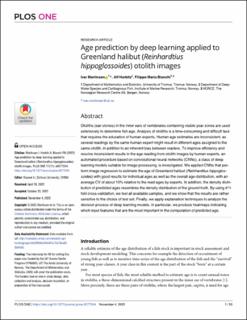| dc.description.abstract | Otoliths (ear-stones) in the inner ears of vertebrates containing visible year zones are used extensively to determine fish age. Analysis of otoliths is a time-consuming and difficult task that requires the education of human experts. Human age estimates are inconsistent, as several readings by the same human expert might result in different ages assigned to the same otolith, in addition to an inherent bias between readers. To improve efficiency and resolve inconsistent results in the age reading from otolith images by human experts, an automated procedure based on convolutional neural networks (CNNs), a class of deep learning models suitable for image processing, is investigated. We applied CNNs that perform image regression to estimate the age of Greenland halibut (Reinhardtius hippoglossoides) with good results for individual ages as well as the overall age distribution, with an average CV of about 10% relative to the read ages by experts. In addition, the density distribution of predicted ages resembles the density distribution of the ground truth. By using k*l-fold cross-validation, we test all available samples, and we show that the results are rather sensitive to the choice of test set. Finally, we apply explanation techniques to analyze the decision process of deep learning models. In particular, we produce heatmaps indicating which input features that are the most important in the computation of predicted age. | en_US |
